Moroccan Food Dishes: Basic Overview
Common Ingredients
Common Cooking Methods
Courses
Meals
Key Taste
Eating Etiquette
Meal Presentation
Culinary Festivals
Influence and Fusion
Popular Types of Moroccan Dishes
-
Stews
Moroccan stews are often cooked with meat, such as beef, lamb, or poultry.
Vegetables and dried fruits appear in certain stew recipes.
Moroccans often use traditional earthenware pots to prepare stews.
These dishes are usually seasoned with a lot of fragrant spices and herbs.
-
Soups
Soups in Morocco have diverse ingredients, such as meat, legumes, or vegetables.
These soups are ideal dishes for special occasions, especially Ramadan.
Moroccan soups are often thick, flavorful, and can be an appetizer or a meal in themselves.
-
Breads and doughs
Bread is the cornerstone of Moroccan cuisine and is present at almost every meal.
Moroccan flatbread is a popular side dish that often serves as a utensil for scooping up food.
Baking and pan-frying are popular ways of preparing bread in Morocco.
-
Desserts
Many Moroccan desserts are pastries infused with spices, aromatic water, or honey.
These desserts usually have a crispy or flaky texture.
Nuts and dried fruits are popular ingredients for making sweet desserts in Morocco.
Desserts are an important part of celebrations in Morocco.
Moroccan dishes are specialties prepared and enjoyed by the people of Morocco, a country in North Africa. These dishes are part of Maghreb cuisine, which also covers the culinary traditions of Algeria, Libya, Mauritania, and Tunisia.
Moroccan dishes are celebrated for their delicious flavors and alluring aromas. These qualities result from the various fragrant spices and herbs that locals use extensively in their food.
Other important ingredients in Moroccan cuisine are lean protein, legumes, and vegetables. These components are often prepared in traditional clay cookware into healthy and tasty dishes.
Continue reading to discover the 26 most well-known dishes in Moroccan cuisine. To help you understand more about traditional Moroccan food, I will go over its main characteristics, global popularity, and healthy aspects.
After introducing you to the recommended dishes, I will cover factors that define Moroccan dishes, ideal food and drink pairings, and table manners in Morocco.
Are you ready to discover the wonders of Moroccan dishes?
26 Most Popular Moroccan Dishes
Discover the top 26 Moroccan dishes listed by popularity below. You can navigate this content more easily by using advanced filters like alphabetical sorting, main ingredients, taste, cooking methods, dish types, courses, and global popularity.
Also, you have the option to filter the list based on specific culinary styles such as traditional, national, street food, fusion, exotic, and vegetarian options.
Couscous
- National
- Traditional
Couscous is a staple Moroccan dish prepared by steaming small granules of rolled semolina. Outside Morocco, it is also well-known in other North African countries, such as Algeria, Tunisia, and Mauritania.
Plain or herbed couscous is an ideal side dish to pair with stews and various savory dishes. Some people also serve couscous as a dessert by sprinkling some cinnamon, sugar, or nuts on the top.
Moroccans eat couscous by shaping it into a compact ball with the right hand, using only the thumb and first two fingers. Couscous takes center stage in Moroccan homes every Friday, a holy day akin to Sunday in Western cultures.
Tajine
- National
- Traditional
Tajine, or tagine, is a famous stew in Morocco and other North African countries. It consists of meat (sometimes replaced with fish or poultry), vegetables, and various spices, including paprika, cumin, cinnamon, saffron, ginger, and turmeric.
The name tajine comes from the earthenware pot used to prepare this stew. This word was derived from the Berber word “tajin,” meaning “shallow earthen pot.”
An unglazed tajine vessel features a flat circular base for cooking and serving, as well as an iconic conical lid. This lid design works to trap steam, returning condensed moisture to the simmering dish below, resulting in impeccably tenderized meat and water conservation.
As a stew, tajine showcases a perfect balance of sweet and sour flavors, often incorporating fresh herbs, olives, preserved lemon, nuts, and dried fruit. Locals usually enjoy it with bread, couscous, and, sometimes, poached eggs.
One must-try variation is kefta tagine, a dish featuring spiced beef or lamb meatballs bathed in a vibrant tomato sauce.
Harira
- Traditional
Harina is a classic soup from Morocco and Algeria. It is a Ramadan staple that is commonly served at iftar, the evening meal that marks the end of the daily fast.
Harina consists of tadouira (a thickening agent composed of flour and water), lentils, chickpeas, fava beans, tomatoes, rice, eggs, and meat (ideally chicken, beef, or lamb).
These ingredients are cooked in broth and seasoned with turmeric, cinnamon, or even saffron to achieve a stunning color. Most Moroccans enjoy harina as an appetizer or a light snack.
Bastilla
- Traditional
Bastilla, also known as pastilla or North African meat pie, is a savory pie with a history rooted in the 10th century. It is also popular in Algeria and showcases the perfect fusion of Andalusian and North African flavors.
The core ingredients of bastilla are warqa dough (crispy, paper-thin pastry leaves) for the exterior and slow-cooked poultry or seafood for the filling. A sweet layer of crushed almonds, cinnamon, and sugar further adorns the exterior.
The name bastilla was derived from the Spanish word “pastilla,” translating to “small pastry.” This pie was once made with pigeon meat but is now more commonly prepared with chicken.
Baked to a golden hue, this savory-sweet Moroccan pie offers an irresistible aroma and taste. For those craving a fiery twist, seafood bastilla offers a spicier alternative.
Méchoui
- Traditional
Méchoui is a roasted Moroccan dish made with a whole lamb or sheep. The animal is skewered by a tree branch and roasted slowly with a spindle over a wood fire to evenly distribute heat.
People frequently serve méchoui as an appetizer at lavish feasts, serving pieces of succulent meat to esteemed guests. It takes about four to five hours to cook méchoui, demonstrating how special this dish is.
The term “méchoui” comes from the Arabic word “šawā”, which means roasting or grilling. This iconic roasted dish is popular throughout North Africa.
Briouat
- Traditional
Briouat, or briwat, is a popular Moroccan puff pastry available in both sweet and savory varieties. Its name is a plural form of “briwa”, which means “letters.”
The savory version is made with meat (lamb or chicken), cheese, pepper, and lemon. A typical briouat is wrapped with thin warqa dough and shaped into a cylinder or triangular form.
Briouats are a flaky, deep-fried appetizer that is highly common during Ramadan. Locals prepare them in large batches alongside other traditional Moroccan sweets, such as chebakia and sellou (a roasted flour dessert).
Msemmen
- Traditional
Msemmen, or rghaif, is a popular flatbread or pancake in Morocco and other countries in the Maghreb region. It is composed of durum wheat semolina, flour, soft butter, salt, sugar, dry yeast, and water.
Moroccans prepare msemmen by molding the dough into thin circles, folding them into squares, and adding butter and extra semolina. Each square is then cooked to a crisp, golden brown finish on a griddle or frying pan.
Msemmen shines in both sweet and savory variations, making it a perfect snack, street food, and breakfast dish. It pairs well with hot honey and butter dipping sauce.
Those who lean towards savory fare can fill this Moroccan flatbread with an assortment of ingredients, such as onions, herbs, and spices, as well as ground beef or lamb.
If you have a soft spot for pancakes or crepes, you’ll undoubtedly be captivated by the buttery, melt-in-your-mouth texture of msemmen.
Khobz
- Traditional
Khobz is an iconic Moroccan flatbread that measures about 1 inch in thickness and up to 12 inches in diameter. Appreciated for its coarse texture and adaptability, it is a mainstay in Moroccan meals.
Made from white flour, this disc-shaped bread is a ubiquitous staple dish that Moroccans commonly use to scoop up honey, cheese, dips, salads, tagines, and other dishes. Khobz also works well as a base for grilled meats and sandwich ingredients.
Although khobz can be easily purchased at local bakeries, many Moroccan households take pride in crafting homemade khobz (khobz dyal dar) and baking it in either home ovens or communal wood-fired ovens called ferran.
Zaalouk
- Traditional
Zaalouk is a well-known Moroccan salad made of tomatoes and cooked eggplants. It is normally eaten warm as a starter or a dip with bread, particularly in the cold season.
To make zaalouk, people grill eggplants, then combine them with fresh tomatoes, garlic, olive oil, lemon juice, and spices. These ingredients result in a flavor-packed dish that can captivate any palate.
Maakouda
- Traditional
Maakouda, also known as ma’quda, is a Moroccan dish of fritters or patties made from mashed potatoes. It hailed from Algeria and is also present in Tunisia.
Maakouda, literally “thick” or “knotted/ bound,” is a common appetizer and side dish. This potato-based fritter can be served plain, stuffed into bread as a sandwich, or stuffed with savory ingredients.
During Ramadan, many Moroccans love to buy maakouda from street stalls.
Taktouka
- Traditional
Taktouka is a Moroccan salad made from cooked bell peppers, tomatoes, paprika, and olive oil. The vegetables can be ground or cut into small pieces.
Taktouka shines as a versatile side dish, effortlessly complementing grilled meat and fish creations. Alternatively, it can pair with freshly baked bread as a delectable dip.
In the eastern region of Morocco, people refer to taktouka as taktouka flifla.
Bissara
- Traditional
Bissara, or bessara, is a popular Moroccan bean soup. Its former name is beesoro, which means “cooked beans.”
Skillfully prepared by simmering legumes with garlic, cumin, cayenne pepper, paprika, and olive oil, bissara transforms into a smooth, velvety delight.
Moroccan-style bissara comes in two variations. One is in the form of split pea soup, which is perfect for chilly days. The other consists of dried fava beans to create a delicious dip and is more famous in the Northern regions of Morocco.
While the ingredients for both bissara versions are quite similar, their textures are different. Both versions grace the streets of Morocco as a beloved street food, offering a comforting embrace during the chilly winter months.
Harcha
- Traditional
Harcha is a Moroccan flatbread hailing from the Middle Atlas mountains. A Ramadan staple, it consists of semolina, milk, and butter.
The name harcha, which translates to “rough” in Arabic, reflects the bread’s distinctive crispy and coarse exterior. This texture is achieved by rolling the flatbread in coarse semolina and cooking on a griddle until it turns golden.
Locals mainly serve harcha as a breakfast dish or crumble it to add to stews. Its popular accompaniments are cheese, preserves, honey-butter syrup, and mint tea.
Harcha is a staple during Ramadan.
Originating from the picturesque Middle Atlas mountains of Morocco, Harcha is a tasty bread creation that combines the allure of English muffins with the comforting taste and texture of cornbread.
Batbout
- Traditional
Batbout is the Moroccan version of pita bread, a group of yeast-leavened round flatbreads with an interior pocket. It features a chewy but soft texture that can go well with various savory dishes.
The main ingredients of batbout are yeast, flour, semolina, water, oil, and water. Unlike Middle Eastern pita bread made by an oven, this version is acceptable to cook on a stovetop or griddle.
As batbout features a pocket, it is an ideal container for a range of sandwich fillings. When enjoyed solo, batbout is commonly consumed at breakfast with spreads such as butter, honey, or jam.
Alternatively, people serve batbout as a side dish alongside grilled meat entrees.
Qrashel
- Traditional
Qrashel, or krachel, is a popular bite-sized bread roll in Moroccan cuisine. Its main ingredients are dough, orange flower water, anise seeds, and sesame seeds.
To give qrashel its deep golden hue, people often coat it in egg wash and sprinkle it with sesame seeds prior to baking.
What I love about qrashel is that it isn’t too sweet but fragrant with a distinctive taste. This aromatic bread roll is great for breakfast when paired with butter, cream cheese, jam, coffee, or tea.
Additionally, qrashel is often incorporated into iftar meals to end the day’s fast during Ramadan.
Baghrir
- Traditional
Baghrir is a Moroccan pancake that boasts a unique, spongy texture. Also known as the “thousand-hole pancake,” it is crafted from semolina flour, yielding a light and airy creation.
Rooted in the Berber culinary heritage of North Africa, baghrir is cherished by Moroccans and Algerians alike, both of whom claim its origin. Nowadays, this pancake is also well-liked in Tunisia.
The magic of baghrir lies in its countless tiny holes, which form naturally during the cooking process, eagerly awaiting a sauce to seep in. This peculiar characteristic sets baghrir apart from other pancakes.
Baghrir is a popular snack, breakfast dish, and Ramadan specialty. The Mozabite people of Algeria have a cherished tradition called m’layin on the 9th day of Ramadan when they exchange these scrumptious pancakes.
Though typically dipped in a honey-butter mixture, baghrir goes well with other accompaniments, such as jam.
Moufleta
- Traditional
Moufleta is a Moroccan pancake associated with Jewish cuisine. Originating from the Jewish communities of the Maghreb, particularly Morocco, it is commonly served during the Mimouna celebration, which takes place the day after Passover.
Moufleta is a delicate, thin crêpe crafted from a simple blend of water, flour, and oil. Its charm lies in its skillful preparation, as the dough is carefully rolled out and gently cooked in a greased frying pan until it achieves a tantalizing yellow-brown hue.
Once warm and ready, moufleta becomes a canvas for an array of toppings. Drizzle it with golden honey, slather it with velvety butter, or adorn it with your choice of flavorful jams, syrups, crunchy walnuts, pistachios, and even dried fruits.
Shakshuka
- Traditional
Shakshuka, literally “mixture,” is a popular egg-based dish in Morocco. It dates back to mid-16th-century Ottoman North Africa.
Moroccans prepare shakshuka by poaching eggs with various spices in a tomato sauce. Each Shakshuka recipe is unique, with some incorporating preserved lemon, olives, harissa (hot chili pepper paste), sausage, cheese, or minced lamb.
Served straight from the pan it was cooked in, shakshuka invites you to enjoy its rich tomato sauce and soft poached egg with crusty Moroccan bread.
Tangia
- Traditional
Tangia, literally “daughter of ashes,” is a Moroccan slow-cooked dish made with meat and optional vegetables. It is a specialty of Marrakesh, a large city in western Morocco.
Although tangia follows the same concept as tajine, it cooks food using the heat of smoldering ashes and takes more time to prepare. Tangia is also the name of the urn-shaped cooking vessel made of clay that locals employ to prepare this stew.
Tangia was more popular among men, especially unmarried ones, so people referred to this dish as “bachelor’s stew.” If you do not have a tangia pot, you can use another clay-based pot or a Dutch oven.
Depending on the specific recipes, tangia can be savory, sweet, or tangy.
Rfissa
- Traditional
Rfissa is a Moroccan chicken dish prepared with many ingredients, such as bread, lentils, onions, fenugreek seeds, saffron, and other spices. The chicken and lentils are simmered until tender and served on a bed of shredded and steamed bread (such as msemmen).
Rfissa has a close association with tharid, a classic Arab dish prevalent in UAE and Saudi Arabia. This chicken dish officially appeared in Moroccan cookbooks around the 1990s, but its recipe had long been well-known in rural areas.
Moroccans typically serve rfissa on special occasions and family parties.
Chermoula
- Traditional
Chermoula is a well-known thick marinade to increase the flavor of fish or seafood dishes in Morocco and other countries in Northwest Africa. Aside from being a Moroccan staple, it is also widely used in Libyan, Tunisian, and Algerian culinary recipes.
Moroccans often apply chermoula to fish, especially sardines, which account for over 62% of the Moroccan fish haul.
Basically, chermoula is a blend of cumin, paprika, cilantro, parsley, preserved lemons, olive oil, and basic seasonings. This mixture can be used immediately or stored in the fridge for later.
Babbouche
- Exotic
- Street Food
- Traditional
Babbouche is a Moroccan soup made with snails. It is a common street food, especially in Marrakesh.
To prepare babbouche, the snails are cooked in broth with various ingredients like mint, thyme, licorice, caraway, and aniseed. Do not ask for a fork to eat the snail; instead, you will need a toothpick to get the snail meat out of its shell.
Sfenj
- Street Food
- Traditional
Sfenj, literally “sponge,” is a Moroccan crispy and spongy doughnut with a golden appearance. It originated in Al-Andalus, the Iberian Peninsula’s Muslim-dominated area.
Nowadays, sfenj is an indispensable snack all over North Africa. People usually enjoy it as a dessert or breakfast with a cup of tea.
Stenji is very spongy and fluffy, with a crispy exterior and airy interior. While this spongy doughnut is delicious on its own, adding some sugar or dipping in honey will significantly improve its taste.
Chebakia
- Traditional
Chebakia, or shebakia, is a Moroccan deep-fried pastry dessert made of dough strips and shaped into a flower. It is coated with honey and sprinkled with sesame on the top.
Similar to harira, chebakia is customarily enjoyed to break the fast during Ramadan. However, it is also commonly prepared to mark various other festivities.
Kaab el Ghazal
- Traditional
Kaab el ghazal is a crescent-shaped cookie in Moroccan cuisine. It is made of flour dough with the filling of almond paste and orange blossom water, then baked to have a golden outside layer.
Kaab el ghazal means “gazelle ankles” in Arabic. Its alternative names include cornes de gazelle (in French) or gazelle horns.
Kaab el ghazal is often enriched with a touch of cinnamon for added warmth. Kaab el ghazal is rather expensive and typically reserved for special occasions, such as weddings.
Sellou
- Traditional
Sellou, also known as slilou or sfouf, is a Moroccan dessert prepared by mixing roasted flour with toasted sesame seeds and ground and fried almonds.
These ingredients impart a nutty quality to sellou, while cinnamon and anise add fragrant aromas. This dessert can come in many shapes and is molded by hand or with a mold.
Sellou is a highly nutritious and calorie-dense dessert to serve during Ramadan. Many Moroccan women who are breastfeeding add sellou into their diet.
Now that you know about the most popular dishes in Morocco, I will go over the basic features of Moroccan cuisine.
What Are the Main Features of Moroccan Cuisine?
To understand Moroccan culinary traditions, you should learn about the following four aspects: culinary influences, herbs and spices, religious influences, and the importance of bread.
Moroccan food is a delicious fusion of Berber, Arab, Andalusian, and Mediterranean influences.
The native Berbers utilized local ingredients, such as olives, figs, and dates. Arab invaders brought with them new spices like saffron, cinnamon, and ginger, as well as new cooking techniques such as slow-cooking in tagines.
Andalusian Moors, fleeing from Spain, introduced additional ingredients like citrus fruits and almonds, while Ottoman Turks contributed to the use of pastries in the Moroccan culinary repertoire.
Finally, Spanish exchange and French colonization added a touch of European refinement to Moroccan dishes.
Spices play a central role in Moroccan cuisine, while fresh herbs add depth and freshness to Moroccan dishes. The careful balance of spices and herbs creates exquisite flavors that set Moroccan cuisine apart from other culinary traditions.
As Islam, Morocco’s dominant religion, forbids the consumption of pork, locals don’t consume this type of meat.
Ramadan, the Islamic month of fasting, is an important time for Moroccan Muslims. During this period, they prepare many special dishes for the iftar meal after sunset.
Another significant religious occasion is Eid al-Adha, the Festival of Sacrifice, during which families gather to share a special meal featuring lamb, often cooked in a tagine or roasted.
Bread has a near-sacred status in Moroccan consciousness and is served as an essential side dish at all meals. People use it as a utensil for scooping up food.
Wasting bread is severely frowned upon in Morocco. Stale or unused bread is incorporated into other dishes rather than being thrown away.
If a loaf of bread drops to the floor, Moroccans always pick it up immediately; some people even kiss it.
In the next section, I will introduce you to common beverages for complementing dishes in Moroccan cuisine.
What Beverages to Pair With Moroccan Dishes?
Below are the three most well-known beverages in Morocco that you can enjoy with various local specialties.
Mint Tea
Mint tea is a highly versatile Moroccan beverage that can pair with a wide range of dishes, though light dishes and snacks are more suitable for it. Recommended accompaniments are chebakia, msemmen, and harcha.
Coffee
Coffee in Morocco is typically strong and can be served either black or with milk; the latter is called nous nous. With its bitter taste, this beverage goes well with robust dishes and sweets, such as qrashel, kaab el ghazal, and baghrir.
Fruit Juices
Moroccans enjoy various types of fruit juices, especially orange juice. These beverages can accompany light dishes like salads (zaalouk and taktouka), briouats, and batbout.
Next, I will cover some basic rules of table manners in Morocco.
What Is Eating Etiquette in Morocco?
To enjoy Moroccan dishes like a local, you should follow the rules and customs of dining below.
Communal Dining
Communal dining is an important part of Moroccan culture, with family and friends often gathering to share meals together.
Eating with the right hand is customary, and diners take turns scooping up food from a shared platter, usually starting with the person closest to the dish and moving clockwise.
Importance of Hospitality
Hospitality is a central tenet of Moroccan culture, and hosts take great pride in welcoming guests and ensuring their comfort.
Offering food and drink is a common way to demonstrate hospitality, with guests often being greeted with a glass of refreshing mint tea and a platter of cookies or pastries.
It is considered impolite to refuse food when offered, as it may be seen as a rejection of the host’s generosity.
Pre-meal Rituals
Before a meal, Moroccans wash their hands, typically using rose or orange-scented water. Dining with a family commences once the host proclaims “Bismillah” (“in the name of Allah”), and everyone else repeats the phrase.
I hope my dish recommendations have shown you the culinary wonder of Morocco. Don’t forget to share this list of Moroccan dishes with your friends.
Also, would love to hear your opinion or experience with the suggested dishes, so go ahead and write it down in the comment section!


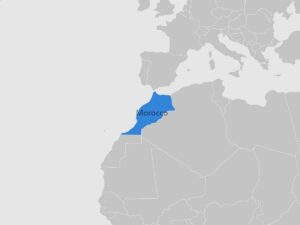
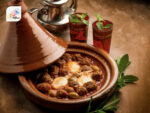
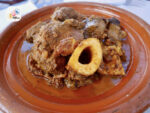
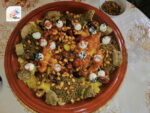
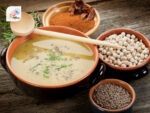
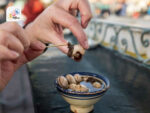
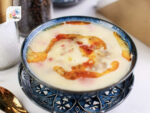
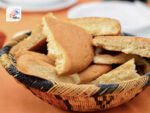
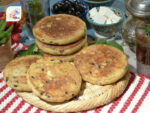
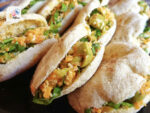
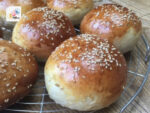

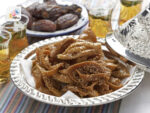
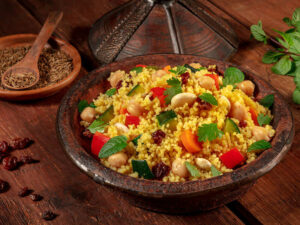
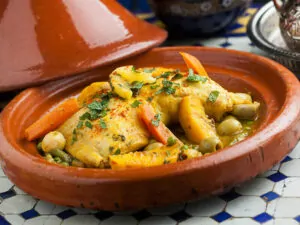
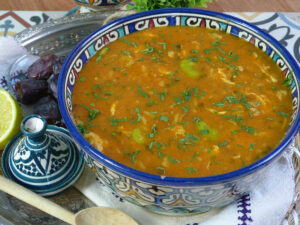
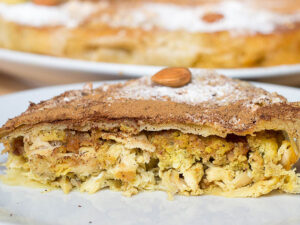
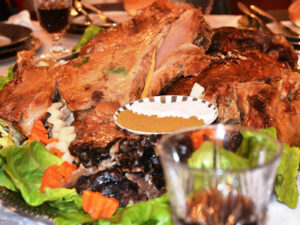
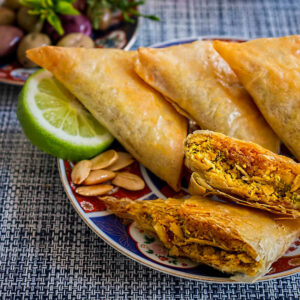
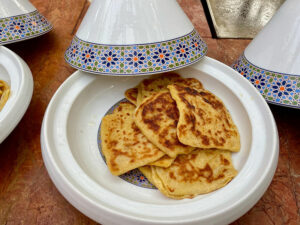
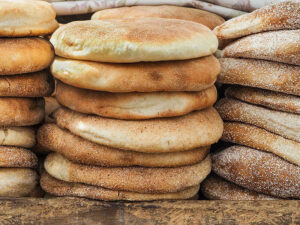
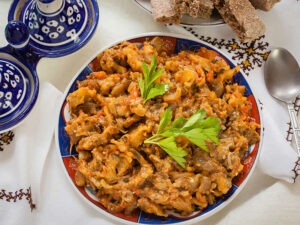
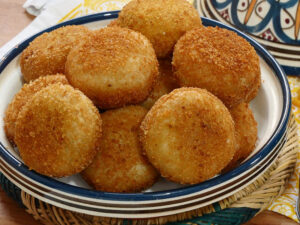
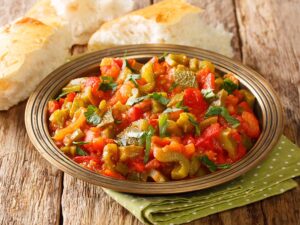
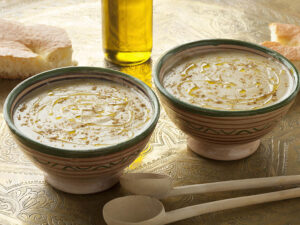
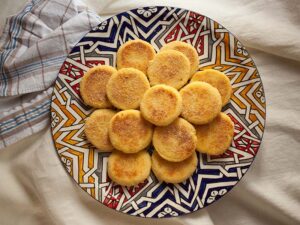
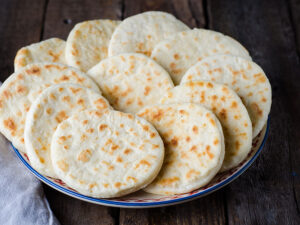
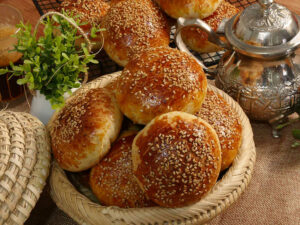
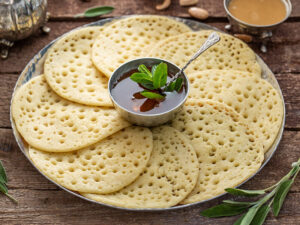
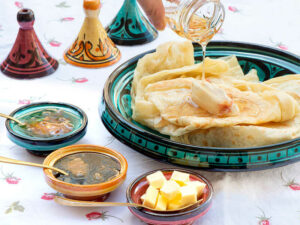
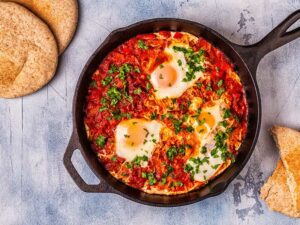
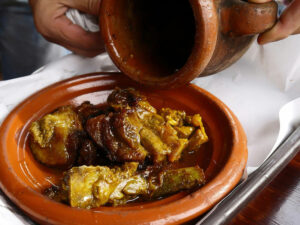
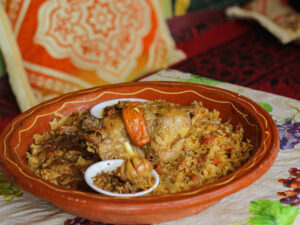
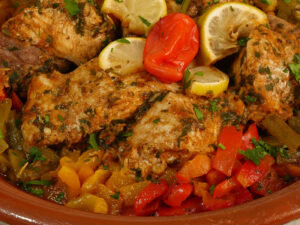
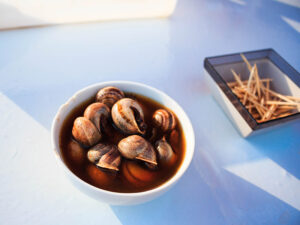
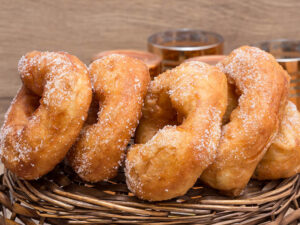
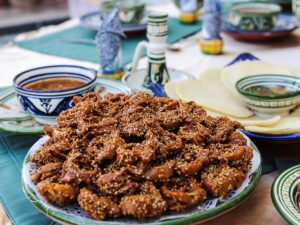
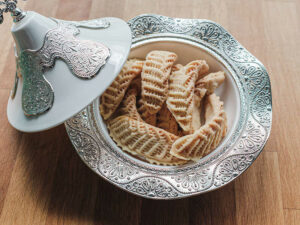
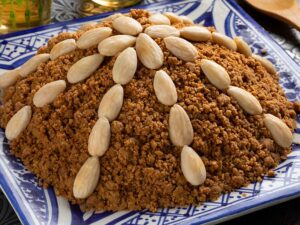
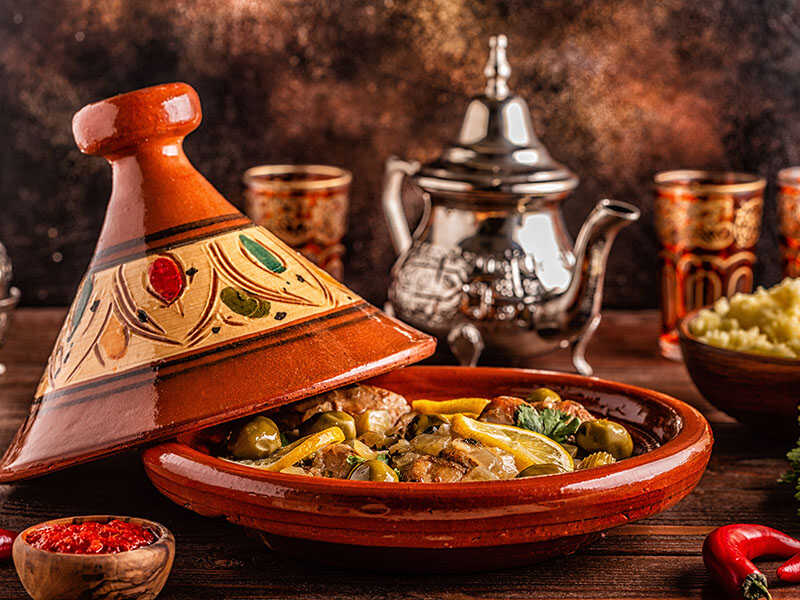
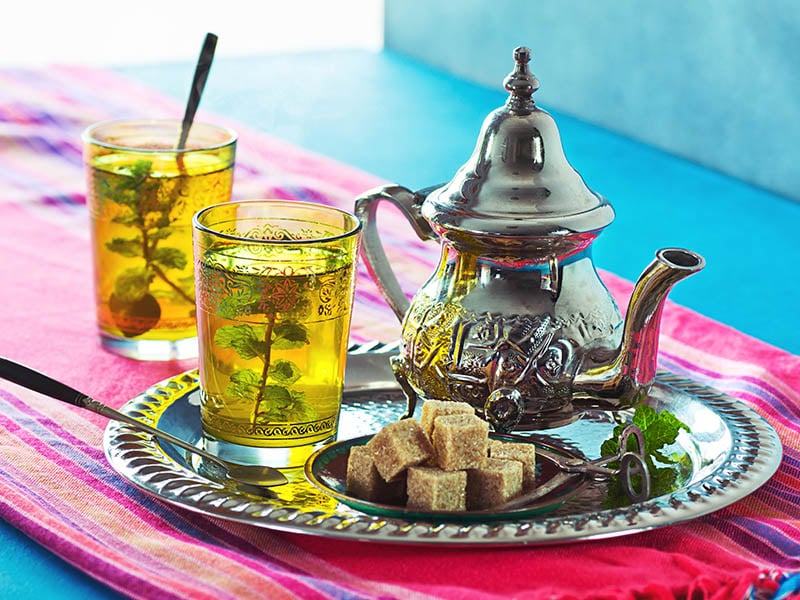
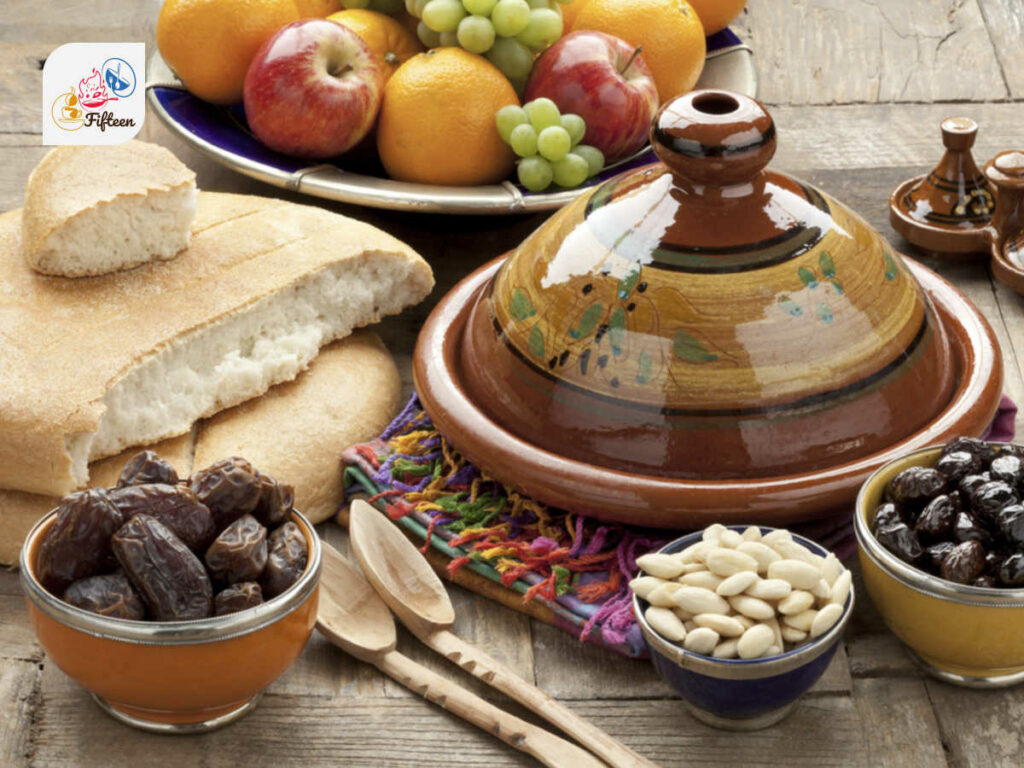
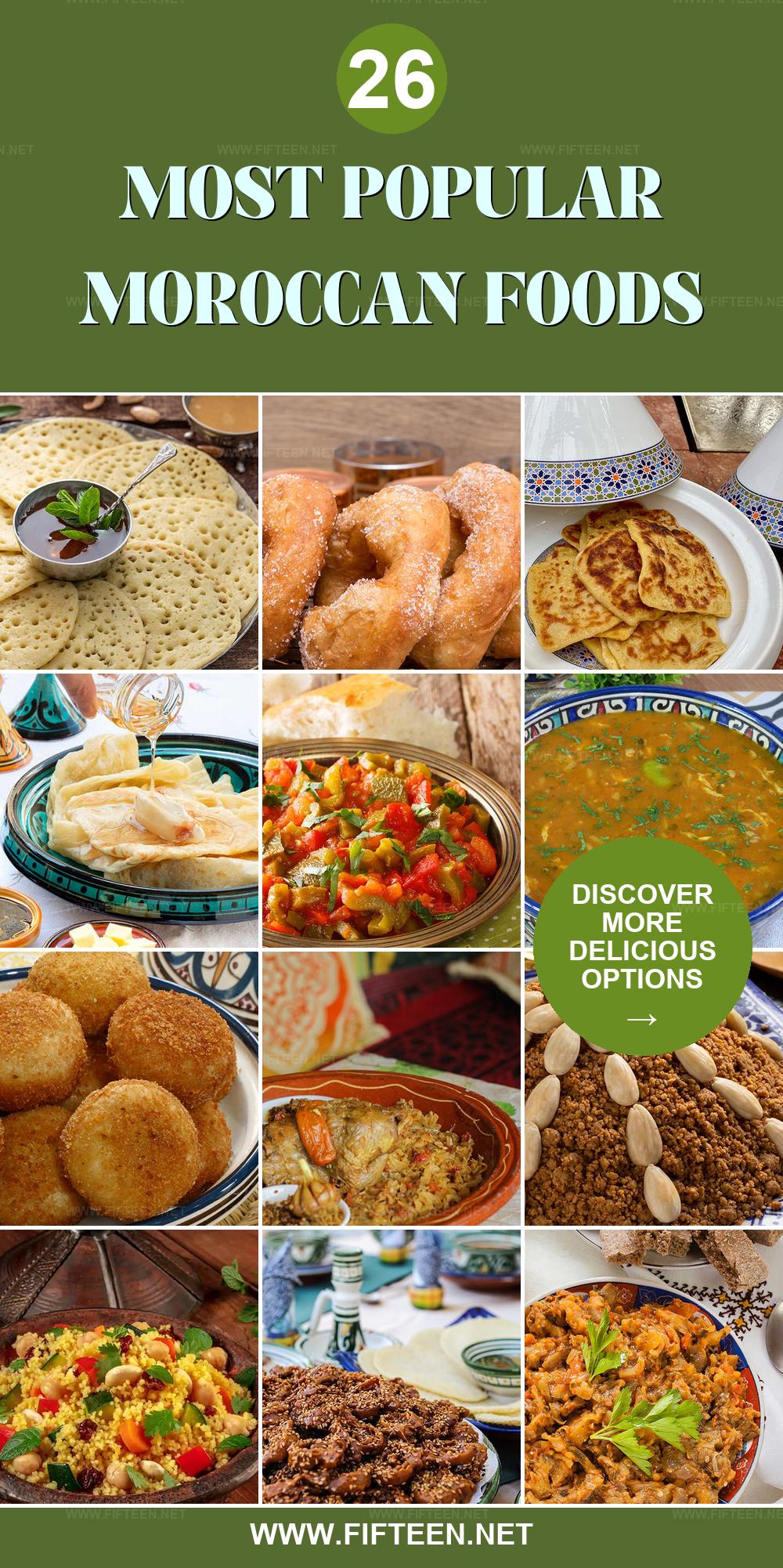
Jamie Scott
Editor in Chief, Senior Content Writer
Expertise
Home Cooking, Meal Planning, Recipe Development, Baking and Pastry, Food Editor, Cooking-video Maker, Western Food Evaluation Expert
Education
Le Cordon Bleu College of Culinary Arts
Local Community College, New York, NY
Jamie Scott is a skilled culinary expert and content creator specializing in Western cuisine. With over 15 years in the culinary field and formal training from Le Cordon Bleu, Paris, Jamie deeply understands how to blend nutrition with delicious flavors. His passion for cooking matches his commitment to making healthy eating accessible and enjoyable.
On Fifteen.net, Jamie brings a fresh perspective to classic dishes and beverages, offering readers insightful recipes, cooking tips, and a fresh view on meal planning that emphasizes taste, health, and simplicity.